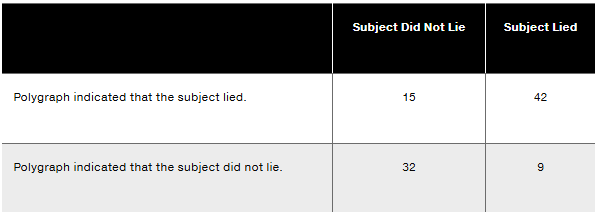Table of contents
- 1. Intro to Stats and Collecting Data55m
- 2. Describing Data with Tables and Graphs1h 55m
- 3. Describing Data Numerically1h 45m
- 4. Probability2h 16m
- 5. Binomial Distribution & Discrete Random Variables2h 33m
- 6. Normal Distribution and Continuous Random Variables1h 38m
- 7. Sampling Distributions & Confidence Intervals: Mean1h 3m
- 8. Sampling Distributions & Confidence Intervals: Proportion1h 12m
- 9. Hypothesis Testing for One Sample1h 1m
- 10. Hypothesis Testing for Two Samples2h 8m
- 11. Correlation48m
- 12. Regression1h 4m
- 13. Chi-Square Tests & Goodness of Fit1h 20m
- 14. ANOVA1h 0m
4. Probability
Complements
Problem 4.3.18
Textbook Question
In Exercises 17ŌĆō20, refer to the accompanying table showing results from experiments conducted by researchers Charles R. Honts (Boise State University) and Gordon H. Barland (Department of Defense Polygraph Institute). In each case, it was known whether or not the subject lied, so the table indicates when the polygraph (lie detector) test was correct.

False Negative Find the probability of selecting a subject with a negative polygraph result, given that the subject lied. What would be an unfavorable consequence of this error?
 Verified step by step guidance
Verified step by step guidance1
Step 1: Understand the problem. We are tasked with finding the probability of selecting a subject with a negative polygraph result (polygraph indicated the subject did not lie), given that the subject actually lied. This is a conditional probability problem.
Step 2: Identify the relevant data from the table. From the table, the number of subjects who lied and had a negative polygraph result is 9. The total number of subjects who lied is the sum of the values in the 'Subject Lied' column, which is 42 + 9 = 51.
Step 3: Write the formula for conditional probability. The probability of event A given event B is calculated as: P(A|B) = P(A Ōł® B) / P(B). Here, A is 'negative polygraph result' and B is 'subject lied'.
Step 4: Substitute the values into the formula. P(A Ōł® B) is the number of subjects who lied and had a negative polygraph result (9), divided by the total number of subjects (15 + 42 + 32 + 9 = 98). P(B) is the number of subjects who lied (51), divided by the total number of subjects (98).
Step 5: Discuss the unfavorable consequence of this error. A false negative means the polygraph test incorrectly indicates that a lying subject did not lie. This could lead to a situation where a guilty person is wrongly deemed truthful, potentially undermining justice or security.
 Verified video answer for a similar problem:
Verified video answer for a similar problem:This video solution was recommended by our tutors as helpful for the problem above
Video duration:
4mPlay a video:
Was this helpful?
Key Concepts
Here are the essential concepts you must grasp in order to answer the question correctly.
False Negative
A false negative occurs when a test fails to identify a condition that is present. In the context of the polygraph test, it means that the test indicated a subject did not lie when, in fact, they did. This type of error can lead to significant consequences, such as allowing a deceptive individual to go unpunished.
Recommended video:
Guided course

Probability From Given Z-Scores - TI-84 (CE) Calculator
Probability
Probability is a measure of the likelihood that a particular event will occur, expressed as a number between 0 and 1. In this scenario, calculating the probability of selecting a subject with a negative polygraph result given that they lied involves using the relevant counts from the table to determine the ratio of false negatives to the total number of subjects who lied.
Recommended video:

Introduction to Probability
Confusion Matrix
A confusion matrix is a table used to evaluate the performance of a classification model by comparing predicted classifications to actual outcomes. In this case, the matrix helps visualize the results of the polygraph tests, showing true positives, false positives, true negatives, and false negatives, which are essential for understanding the accuracy and reliability of the test.
Recommended video:
Guided course

Step 4: State Conclusion Example 4

 4:23m
4:23mWatch next
Master Complementary Events with a bite sized video explanation from Patrick
Start learningRelated Videos
Related Practice

